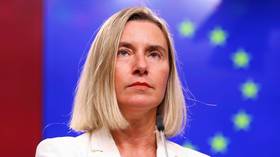Two countries, one tragedy: Russia and Poland join in mourning

One year ago a plane carrying the late Polish President Lech Kaczynski and 95 others crashed near the Russian city of Smolensk. Poland and Russia are remembering a tragedy that left the two nations devastated.
In the heart of the Polish capital in front of the Presidential Palace, thousands of people gathered to commemorate those who died in the plane crash one year ago. They held a minute's silence at 08.41am local time (10.41 Moscow time), the exact moment of the crash. Most of the people gathered near the Presidential Palace were holding candle-lit ceremonies and laying flowers. The twin-brother of the late President Kaczynski was among those to lay a wreath.Commemoration ceremonies have been held at various places across the country and in many of Warsaw’s cathedrals, as well as at the cemetery in Krakow where the president and his wife are buried. A special ceremony was observed on the runway of Warsaw airport; it was the same runway from where the presidential plane took off and never returned.Current President Bronislaw Komorowski paid a visit to Warsaw's Powazki cemetery where many of the crash victims lie. Komorowski appealed for the tragedy not to be a source of conflict. "A year on, we should see what is great, what is good," he said. The names of the 96 victims of the tragedy were read out during the ceremony, and ranks of Polish soldiers fired their rifles in a salute to those who died, while thousands marched through the center of Warsaw to pay tribute to those who perished.Commemoration ceremonies have also been held in the Smolensk region at the actual site of the tragedy. At 10.41 am Moscow time, the moment the plane crashed, a small remembrance service was held. During the day people continued to come to pay their respect to those who died in the tragedy.Ceremonies have been ongoing since Saturday, when the wife of the Polish president Anna Komorowska, together with the families of those who perished in the crash, attended the site of the tragedy by the Smolensk airfield and the memorial where services were held.Russia’s first lady Svetlana Medvedeva laid flowers at the Polish embassy in Moscow on Sunday and left a record in the condelence book. “We share the grief of the Polish people on the anniversary of the tragic air crash near Smolensk, which happened on April 10, 2010. Kindly accept our condolences. The pain of loss has not subdued. We cherish the memory of the deceased,” she wrote.The deadly crash of the Warsaw-Smolensk flight on April 10, 2010, took the lives of 96 people including the Kaczynski presidential couple, the Polish Air Force Commander Lieutenant General Andrzej Błasik, head of the Army Chief of Staff, Gen. Franciszek Gagor; head of the National Security Office Aleksander Szczyglo; Deputy Foreign Minister Andrzej Kremer; head of the National Bank of Poland, Slawomir Skrzypek and many other top Polish officials.The polish delegation was due to attend a memorial service commemorating the 70 anniversary of the Katyn shooting of thousands of Polish officers.
Disputes continue to surround Polish tragedy
By all means, the Katyn tragedy and the Smolensk air crash are very emotional pages in Poland’s history.Still, emotions notwithstanding, the Smolensk tragedy is nowadays being used by certain political forces in Poland for their benefit. The party of deceased president Lech Kaczynski and his brother Jaroslav is using strong anti-Russian rhetoric, sometimes going as far as accusing Russia and the acting Polish government of conspiracy over the death of the previous Polish president. They accuse both Moscow and Warsaw of hiding facts from the investigation. Still, only 5-7 percent of people in Poland believe this theory, according to the polls.Of course the acting Polish President Bronislaw Komorowski and the Prime Minister Donald Tusk are saying they are satisfied with the pace of the investigation. It is very unclear where this political game will go but clearly the emotions of the Polish people are being used for political aims. Another controversy surrounding the tragedy has reached the crash site, where the original memorial stone set there after the crash was supposedly been replaced with a new one on Friday night, as RT correspondent Alice Hibbert reports. The old inscription was written in Polish and made reference to the fact that this was the spot where Lech Kaczynski died, and that he and the Polish delegation were on route to mark the 70th anniversary of the Katyn genocide. The new one that has replaced it is now written in both Polish and Russian, and makes no reference to what happened at Katyn. The exchange has caused some resentment among both the Polish general and political community. Russia’s Ministry of Foreign Affairs responded that the Polish party had been made aware prior to the visit that the wording on the stone required a substitute. The inscription needed to be compliant with Russia’s law on monuments and commemoration plates, which meant adding wording in the Russian language, the official language of the country.The Ministry elaborated that after the crash a decision was made to construct a memorial at the place of the catastrophe. Before that was done, the authorities placed a stone to temporarily mark the place of the tragedy. Sometime later, wording in Polish appeared on the stone, but this action had been neither coordinated with the Russian side, nor explained by the Polish embassy in any way. “Proposals on new wording have been sent to Poland’s Foreign Affairs Office. There was no reaction from their part. In this regard, we consider the comments made by the Polish Foreign Affairs envoy to Russia puzzling, as Poland has been fully informed that taking such actions without an official concord is unacceptable, as well as the wording on the commemoration stone needed to be changed urgently,” the Foreign Affairs ministry said.At the same time, Smolensk local authorities say that permission was never granted for the original stone. Also, they explain that a bilingual memorial allows both Russian and Polish mourners to feel welcome there. The Smolensk authorities say they removed the reference to Katyn as they refute the word 'genocide' – although Russia has taken responsibility for what happened at Katyn, it did not acknowledge that genocide specifically took place there.Also, the latest reports say that the original plate in Polish has been sent as an exhibit to the Katyn memorial, which is 20 kilometers from Smolensk.The Interstate Aviation Committee investigating the case released the details of its report on January 12. They concluded that pilot error was to blame for the crash, compounded by bad weather, poor visibility due to fog and the psychological pressure exerted on the pilots by some of the high-ranking passengers aboard, demanding to land the plane as soon as possible.But some politicians in Poland refute the conclusions of the Committee and say more needs to be done to investigate the conditions of the airport in Smolensk and the role played by the ground staff and if they could have prevented the plane from landing – despite the fact that ground staff does not have the right to overrule a pilot. The pilots of Polish Air Force One asked for permission to land and were definitely told not to do so and head for an alternative airfield.
The doomed flight 101
Right up until the final moments, the altitude controller on the ground demanded that the pilots of the Russian-made Tu-154 carrying the Polish delegation “PULL UP”, but the military pilots of Poland’s Air Force One refused to execute the necessary maneuver for an unknown reason. Within seconds, all 96 on board Flight 101 were dead. The time was 10.41 am.“I was outside when I heard the plane. It was flying really low with one of its wings pointing down. It all happened so fast! It crashed into the trees and burst into a ball of fire,” remembers eyewitness Igor Fomin. “It was obvious that no one was going to survive. The flames were as high as a 5 storey house.”Ground control staff warned these were no conditions to land. But a request was still made to attempt a “trial” approach.Transcripts from the plane’s black box flight recorder reveal the crew was acutely aware of the rapidly decreasing visibility, but also of the pressure to land as soon as possible from an unknown person aboard, who would go “crazy” if they didn’t.The facts show that a senior minister periodically entered the cockpit throughout the flight and that the Chief of the Air Force himself was present in cockpit at the time of the crash.Under these conditions the pilots continued their approach.Having passed the point of no return, the plane began its final descent. But the dense fog and poor visibility meant that the crew had actually already missed their target and were coming into land some 15 meters below the runway – the terrain at the site of the crash is actually lower than the airfield itself just a kilometer ahead. The base of the aircraft began to graze the tops of the trees when one particularly tall birch ripped a large chunk out of the left wing, causing the plane to roll. Within 5 seconds, the nose of the Tupolev 154 had hit the ground. “At first we didn’t know that there was a crash, just that something had happened, that something was wrong. So we took a taxi from Katyn to here [the site of the crash] and came as fast as it was possible,” shared Polish radio journalist Danka Woznicka who covered the crash. “None of that [us] believed it [had] happened, we were talking about it, but it was unreal, incredible.”That sense of shock and disbelief reverberated around the world as the news began to spread.That in a single moment Poland had suffered what its Prime Minister would later dub its worst tragedy since World War II.
“After the crash there was a whole flood of phone calls from Poland, people were asking is it true that President Kaczynski is dead,” remembers Polish radio journalist Rademir Czarnecki, who was waiting for the delegation to arrive in Smolensk.“I did not know what to say, though I’m a journalist and I had to say that my president is dead, crashed on a plane,” Czarnecki says.
The process of mourning for the Smolensk tragedy is being used as a political tool in Poland, insists Professor Tadowsz Iwinski, vice chairman of the Polish Parliament's Foreign Affairs Committee, who was supposed to be on the doomed Flight 101 but because he had already visited Katyn twice, he decided to offer his seat to a colleague who had never been there.Despite certain Polish politicians imputations, only eight per cent of Poles share the opinion that Russian authorities have connections to the Polish president plane’s crash, Tadowsz Iwinski told RT.











